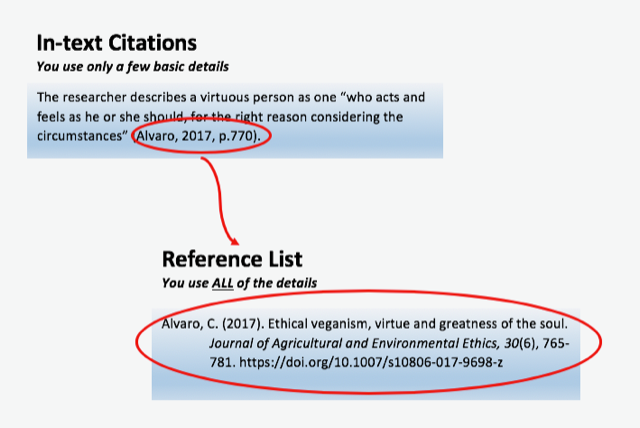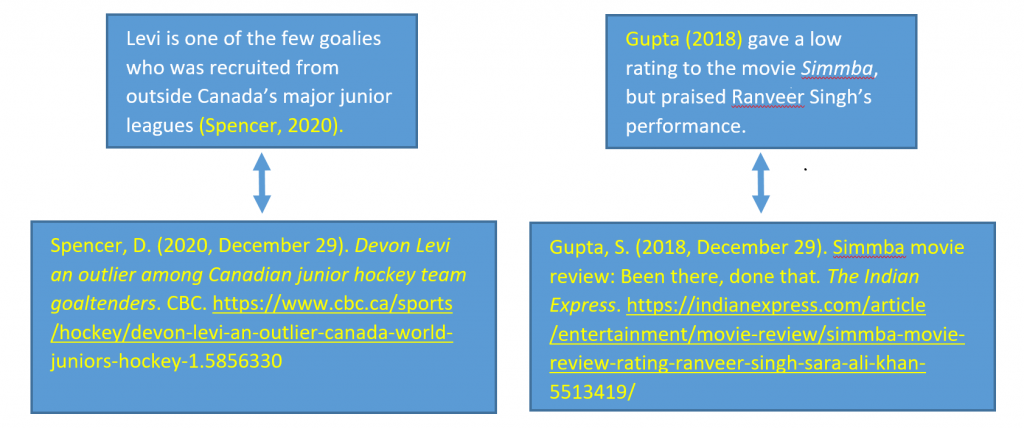Chapter 19: APA Format
“Writing the perfect paper is a lot like a military operation. It takes discipline, foresight, research, strategy, and, if done right, ends in total victory.”
–Ryan Holiday
WHAT IS APA STYLE?
APA Style is a set of guidelines covering many different aspects of scholarly writing, including:
- formatting (title page setup, margins, line spacing, font, headings, etc.)
- mechanics of style (spelling, punctuation, capitalization, italics, etc.)
- grammar
- use of bias-free language
- references/citations
The APA Style Manual is published by the American Psychological Association (APA) and is used in psychology, nursing, business, communications, criminology, engineering, and related fields.
Check out the APA Style website for more info!
FORMATTING THE PAPER
Formatting the Title Page (page 1) for a student paper
- Create a Title Page for your work
- Scroll down to the center of the page and center the following:
- Title of Your Paper
- Bold your title
- Use title caps
- No quotation marks, italics, underline, etc.
- Your Name
- University Affiliation
- Course Name/Number
- Instructor
- Due Date
- Title of Your Paper
Figure 19.1 Title Page Example
Formatting the Beginning of Your Written Content
To start the body of your text follow the proceeding steps:
- Create a new page. This page (and all those that follow) should also include the header without the words “Running head.”
- At the top of the new page, center and write the full title of your work. Do not use bold, underline or quotation marks. After the title, hit enter once, indent your paragraph ½ inch, and begin writing.
Levels 1-3 Headings
APA uses various levels of headings to distinguish sections in an essay. According to the OWL of Purdue, “[t]he levels are organized by levels of subordination, and each section of the paper should start with the highest level of heading.” The highest level of heading is 1 and the lowest is 5. However, in this section, only levels 1 through 3 are discussed.
Level 1 Heading
- Level 1 Heading (Centered, Bolded, Title Caps)
- Shows the section title (e.g. Literature Review, Methods, Results, Implications)
Figure 19.2 Heading 1

Level 2 Heading
- Level 2 Heading (Left-Justified, Bolded, Title Caps)
- Shows subsection titles (e.g. main ideas/topics)
Figure 19.3 Heading 2 Example
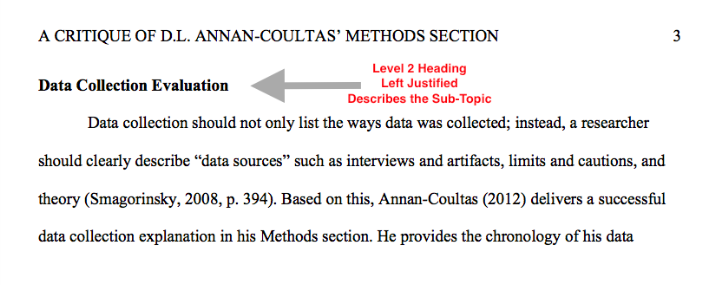
Level 3 Heading
- Level 3 Heading (Indented, bold, lower-case, period)
- Shows subsections of subsections (e.g. sub-topics of topics)
Figure 19.4 Heading 3
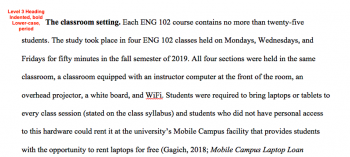
Properly formatted APA citations include two main elements: the reference list entry and the in-text citation. Below you will find sample citations for a variety of commonly-used reference types. For additional questions, consult the Publication Manual of the American Psychological Association (7th ed.)
TWO PARTS OF APA CITATIONS
In APA Style, there are two parts to every citation: an in-text citation and a reference list citation.
In-text citations use only a few details of the source, enough to locate its matching reference citation in the reference list.
Reference list citations provide more information about the source, so that the reader can find it if they wish.
We will discuss both of these separately first and then together later. First, we will discuss reference list citations.
THE REFERENCE LIST
A reference list is an alphabetized list located on a separate page at the end of your paper that lists all the reference citations for the sources used in your paper to support your research.
Each reference citation includes key elements referred to as the Four W’s:
| Author | Date | Title | Source Location |
| Who? | When? | What? | Where? |
 |
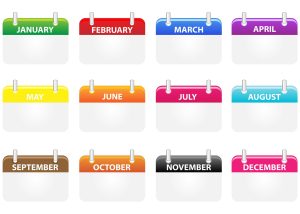 |
 |
 |
Asking these 4 questions helps identify the key elements needed for a reference list citation.
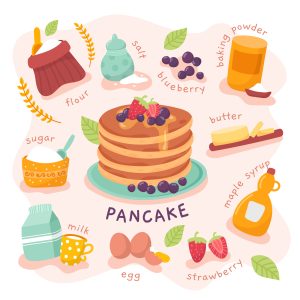
Using APA resources to help create a reference citation is like using a recipe. The ingredients are the key pieces of information about a source (4Ws). If you’re missing an ingredient, leave it out or substitute it.
Following a recipe’s directions is like following a citation example. If you follow the directions and add the ingredients at the right point, then your recipe (i.e. your citation) will turn out!
You are not expected to memorize APA guidelines. Instead, use available resources (APA Quickguide and this tutorial) to help guide you. Over time you will become more comfortable with creating citations yourself.
Creating Reference List Citations: Books/Ebooks
Next, we will use the 4 W’s to look at creating reference citations for the various sources evaluated in the previous chapters. Pay close attention to the punctuation and font emphasis (italic, underline) used.
Step 1: Find the 4 Ws
The 4 Ws for the book (there are four slides)
Step 2: Arrange the 4 Ws in the correct order and with the correct formatting.
The citation for the book (click image to see it bigger)
The example above is an eBook accessed through a library database with no DOI.
- Author: is the book’s individual author.
- As always, use only initials for all given names.
- Date: the copyright date of the book, found on the copyright page (©2011).
- This is the guideline for all books and eBooks. The release date of a book is not used.
- Title: is in sentence-case and italics as it is a stand alone work
- If a title has a subtitle, it is separated by a colon (:) with the first word of the subtitle in upper-case.
- Source location: is the book’s publisher (and for ebooks also the DOI or URL if available)
- If the ebook is in a library database and has no DOI, treat the ebook like a print book and finish the citation with the book publisher; do not include the URL (unless your instructor asks you to do so)
Creating Reference List Citations: Trade Publications
Step 1: Find the 4 Ws
The 4 Ws for the trade article (there are four slides)
Step 2: Arrange the 4 Ws in the correct order and with the correct formatting.
The citation for the trade article (click image to see it bigger):
 The example above is an article in a trade publication accessed through its online version on an open website.
The example above is an article in a trade publication accessed through its online version on an open website.
- Author: the article’s individual author, as always last name followed by initials.
- Date: the publication date of the issue in () parentheses, Year-First, followed by the months.
- Title: the article title in sentence-case.
- Source location: the Publication’s Title (in Title-Case and italics), the article page range, and hyperlinked URL.
- This example has no volume or issue numbers, so they are skipped.
Creating Reference List Citations: Journal Articles
Step 1: Find the 4 Ws
The 4 Ws for the journal article (there are four slides)
Step 2: Arrange the 4 Ws in the correct order and with the correct formatting.
The citation for the journal article (click image to see it bigger)
Creating Reference List Citations: Webpages
Step 1: Find the 4 Ws
The 4 Ws for the webpage (there are four slides)
Step 2: Arrange the 4 Ws in the correct order and with the correct formatting.
The citation for the webpage (click image to see it bigger)
The example above is a webpage with a group author that is the same as the publisher of the website .
- Author: UNESCO is an acronym for the organization’s full name.
- If the author is an acronym, spell out their full name.
- Date: the publication date of the webpage.
- Do not use the website’s copyright date for the date.
- If no publication date is given, use (n.d.), meaning no date.
- Title: is in sentence-case and italics as it is an individual work.
- Source location: is the site name (if different from the author) and URL of the webpage.
- If the author is the same as the site name (as in our example), only the author is included.
Summary of the Four W’s
The infographic below provides an overview of each of the Four W’s with some examples. You can download the full 2-page APA 7th edition overview infographic here:
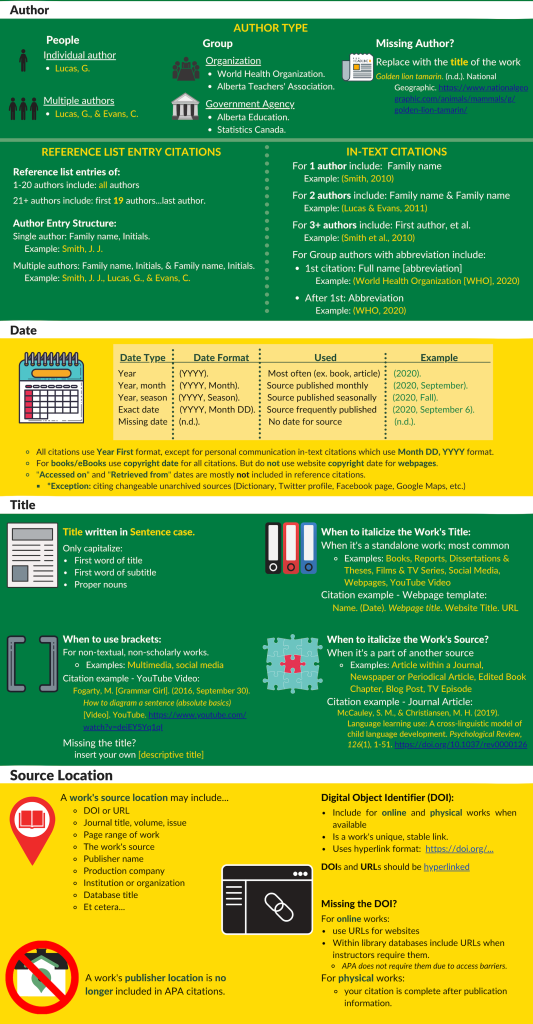
Sample References Page
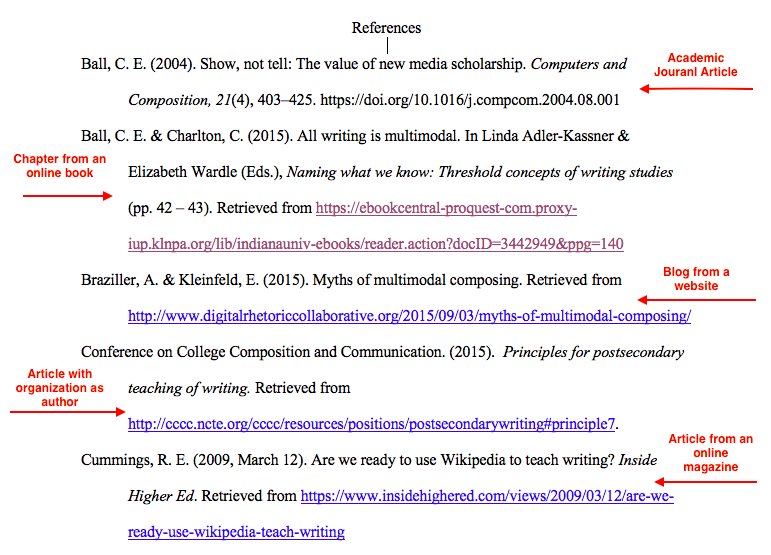
More help on creating a References page
IN-TEXT CITATIONS
If you want to include information from a source you consulted in your paper, you need to create an in-text citation. As mentioned before, in-text citations use only a few details of the source, enough to locate its matching reference citation in the reference list.
In APA style you need to include the following elements for all in-text citations, whether you are citing a book, a journal or trade article, a website or any other item:
- the author’s family name(s) or the group name
- the year
- and if you are quoting word for word, also the page number or other locator*
*Instructors may prefer location information for all in-text citations, so check with your instructor.
Where to place citations in your writing
Because in-text citations tell your reader which ideas belong to you and which ideas belong to someone else, it is crucial that you place them correctly. There are two different ways that you can include in-text citations into your assignments:
- as a parenthetical citation at the end of your sentence
- as a narrative citation as part of the sentence
Examples
1. In-text citation example for a paraphrase
Click on the ![]() symbol to learn about the parenthetical and narrative citation used in these paraphrases.
symbol to learn about the parenthetical and narrative citation used in these paraphrases.
Parenthetical and narrative citation
2. In-text citation examples for a short quote
Click on the ![]() symbol to learn about how to add in-text citations for short quotes (less than 40 words).
symbol to learn about how to add in-text citations for short quotes (less than 40 words).
Narrative Citation
Parenthetical Citation
3. In-text citation examples for a long quote (aka “block” quote)
Click on the ![]() symbol to learn about how to add in-text citations for long quotes (more than 40 words).
symbol to learn about how to add in-text citations for long quotes (more than 40 words).
Narrative Citation
Parenthetical Citation
When there are no page numbers
Some sources don’t have page numbers, in which case you should try to include some other pinpoint, so your reader can find the quote more easily. This could be a section heading, a chapter number, paragraph, and so on.
The image below details some location information examples and their appropriate abbreviation. Also, check out our In-text Citations tab on the APA Citation guide for some examples.
When there is no author. If there are multiple authors. When there is no date.
Whatever the situation, you still need to cite your source. Check out the APA Citation guide for answers to these and other questions, and if you need help, ask your instructor or a writing tutor.
Tip: It is easiest to create the reference citation first and then its matching in-text citation(s).
HOW IT ALL WORKS TOGETHER
As we have covered, reference list citations and in-text citations should match each other. They work together to clearly indicate which sources provide support to your writing.
*One exception is personal communication, which is cited as an in-text citation, but is not included in the reference list.*

Why? Your reader can’t access your personal experiences.
More Help for Creating In-Text Citations
Attributions
APA Style Citations by Ulrike Kestler is licensed under CC BY-NC-SA 4.0


